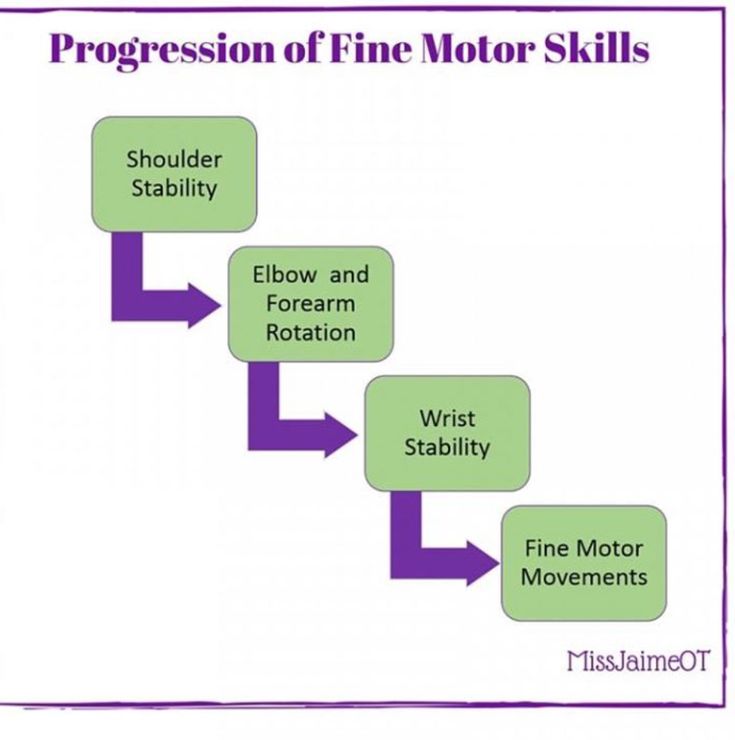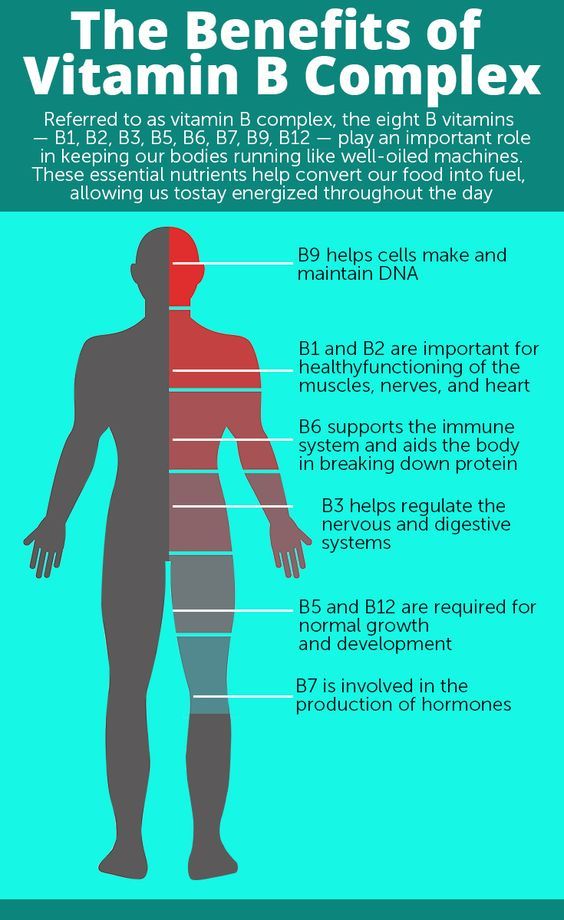Where do umbilical cords come from
How the Umbilical Cord Is Developed
There’s a lot of reading to do when you’re pregnant, from “What To Expect When You’re Expecting” to supply checklists and gift registries. So, it’s understandable if you skimmed over some of the biological topics, like how the umbilical cord is developed. But it’s literally your baby’s lifeline. Knowledge about it can help you understand the role of the umbilical cord and why it’s rich with such valuable contents.
The Ultimate Connection
You can’t underestimate the umbilical cord and how it connects you to your baby. Some have likened it to the cord that tethers an astronaut to their mothership in space. You can sing to your baby and rub your belly, and it’s nurturing—but it’s this tangible link that’s biologically nourishing.
That’s why a baby’s first moments in our world can be such a shock for them. First, the rush of shivery air. Then the cutting of the cord, the baby’s own food delivery service. You’ll have the belly button left behind as a reminder of when you two were physically attached. And if you choose to save the cord blood and tissue, you’ll also have a rare souvenir that just might save a life one day.
Your baby is well on its way before the umbilical cord makes an appearance. They will already be the size of an orange seed before the cord begins to form. The embryo will be starting to resemble an actual fetus, with a pre-spinal cord and brain.
The Fifth Week
The umbilical cord emerges from the remnants of the yolk sac and the allantois, which handles the embryo’s waste. It attaches to the placenta, an organ grown specifically for your baby’s birth. The umbilical cord will eventually be responsible for funneling all the nutrients and oxygen from the mother to the fetus, so it’s a critical time. It will be doing the dirty work of carrying waste away, too.
The Seventh Week
This is where things get a little weird. In addition to everything else it has to do, the umbilical cord now temporarily houses the fetus’s intestines. That’s right—the entire intestinal tract moves out of the fetus’s body into the cord.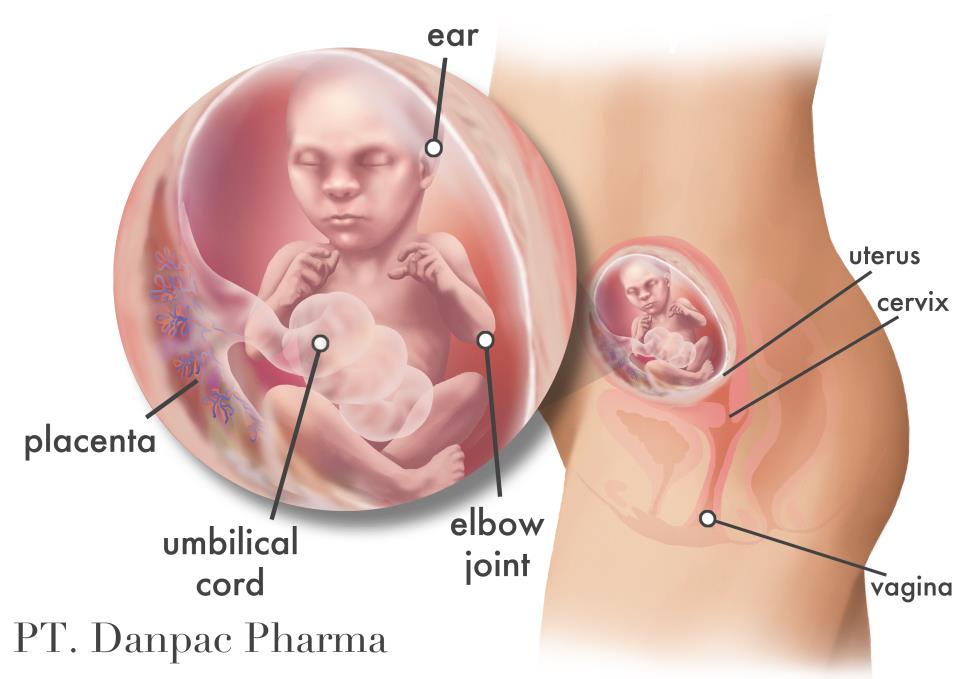 This process is called “herniation.” There’s not enough room for the intestines. Once the fetus has grown larger—around 12 weeks—the intestines will move back into the abdomen.
This process is called “herniation.” There’s not enough room for the intestines. Once the fetus has grown larger—around 12 weeks—the intestines will move back into the abdomen.
The 12
th WeekA key player develops at this point. The main tissue in the cord is called Wharton’s Jelly. It is indeed gelatinous and protects the blood vessels in the umbilical cord. It’s created from some very long words you don’t need to remember, but you should appreciate why it’s so essential. Wharton’s Jelly serves as a cushion inside the cord as it gets twisted and squeezed.
The umbilical cord now has one vein that’s responsible for delivering oxygenated, nutrient-rich blood to the fetus. Once the blood is depleted of the goodies, two arteries carry it away.
The 20
th WeekTo give you an idea of how rapidly the umbilical cord is developed, at 20 weeks, it’s delivering about 35 milliliters of blood. By 40 weeks, that’s risen to 240 milliliters.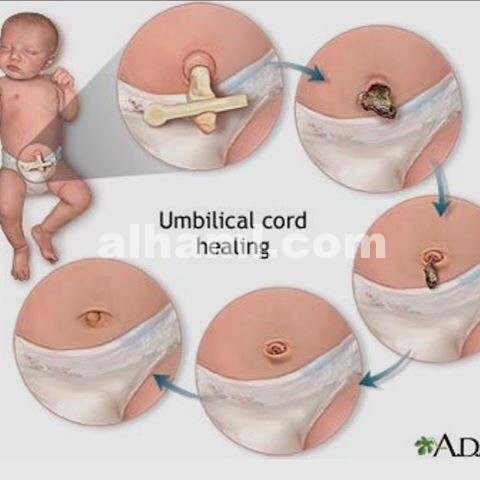
The Second Trimester
This period covers the 13th to the 28th weeks of the pregnancy, and the cord grows in length significantly. As a general rule, it will become the same length as the fetus, from the top of their head to the “rump” (the end of the fetus’s torso). But you’d be surprised by how much it can vary.
The more a baby wriggles about in the womb, the longer the cord. Eventually, the typical umbilical cord will grow to between 20 and 24 inches, and one to two centimeters in diameter. But a shorter cord can be just 13 inches or less and still do the job successfully. Longer cords can extend to 32 inches or the length of two bowling pins laid end to end.
The Rest of Pregnancy
A long umbilical cord is more likely to get tied into knots or get wrapped around the baby, but that wonder-ooze, Wharton’s Jelly, cushions everything within the cord so your baby can grow and thrive. Some mothers like to think of the umbilical cord as their baby’s first toy, as they reach and hold onto it as they float in the comfort of the womb.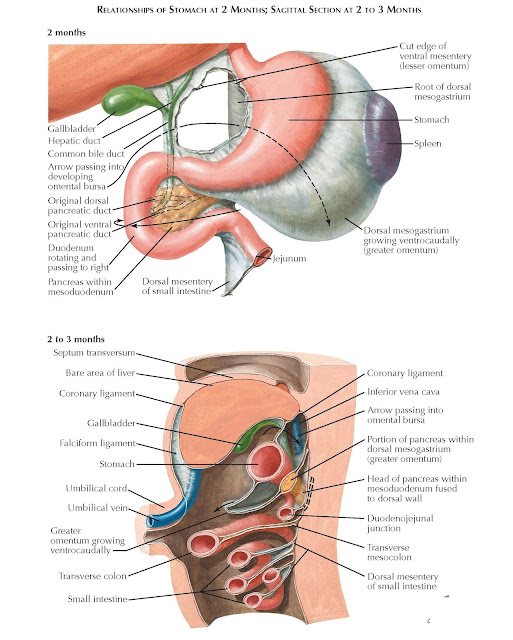 That’s why so many volunteers crochet toy octopuses for premature babies; their tentacles are comforting to grab onto so the babies won’t pull out their tubes and monitors.
That’s why so many volunteers crochet toy octopuses for premature babies; their tentacles are comforting to grab onto so the babies won’t pull out their tubes and monitors.
When Its Job Is Done
Once your baby has been delivered—and cradled in your arms—the umbilical cord has just one purpose left. It contains pure, young stem cells that can be banked to treat about 80 diseases, including leukemia. At the same time, many parents choose to store the accompanying tissue, the Wharton’s Jelly. What is cord tissue used for? Presently, research is ongoing, but doctors are hopeful that they can soon use it to treat diabetes, asthma, bone diseases, autism, cerebral palsy, and more.
Fun Umbilical Cord Facts
It Has No Nerves
When the cord is clamped and cut, the baby and the mother feel no pain. It does, however, feel strange to whoever is cutting it. Some have described it as similar to “cutting into calamari.”
It’s Self-Sealing
If no one was there to cut the cord, it could achieve closure on its own. Once the baby no longer needs it, the Wharton’s Jelly starts to harden and shrink. The blood vessels are closed off, naturally clamping together.
Once the baby no longer needs it, the Wharton’s Jelly starts to harden and shrink. The blood vessels are closed off, naturally clamping together.
It Was Preserved in Many Cultures
In Turkey, parents buried the umbilical cord in a place of knowledge that could influence their child’s future occupation. Many Native American tribes kept the dried cord in a pouch the baby could wear around their neck. In Japan, the cord was kept in a dedicated, decorated wooden box.
A child only comes into contact with an umbilical cord at the very start of their life. But the stem cells and tissue a cord holds could be a valuable healing source for years. At New England Cord Blood Bank, we protect these near-miraculous materials in optimal conditions until your child needs them. Visit our site to find out more.
Embryology, Umbilical Cord - StatPearls
Introduction
The umbilical cord is the vital connection between the fetus and the placenta. Umbilical cord development begins in the embryologic period around week 3 with the formation of the connecting stalk.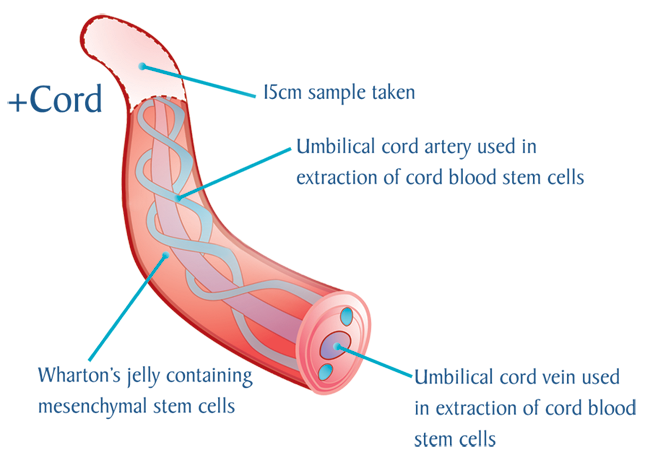 By week 7, the umbilical cord has fully formed, composed of the connecting stalk, vitelline duct, and umbilical vessels surrounding the amniotic membrane. The umbilical vessels carry the fetal blood back and forth to the placenta, with the umbilical vein carrying oxygenated blood with nutrients from the placenta to the fetus and the umbilical arteries transporting deoxygenated blood with waste products from the fetus to the placenta. Embryonic structures regress near the end of the first trimester, leaving the umbilical cord composed of two umbilical arteries and one umbilical vein surrounding by a gelatin-like extracellular matrix known as Wharton’s jelly. Elongation of the umbilical cord occurs primarily in the second trimester. The average umbilical cord is 50 to 60 centimeters in length, 2 centimeters in diameter, with up to 40 helical turns. Abnormalities of the umbilical cord can lead to increased morbidity and mortality of the fetus.
By week 7, the umbilical cord has fully formed, composed of the connecting stalk, vitelline duct, and umbilical vessels surrounding the amniotic membrane. The umbilical vessels carry the fetal blood back and forth to the placenta, with the umbilical vein carrying oxygenated blood with nutrients from the placenta to the fetus and the umbilical arteries transporting deoxygenated blood with waste products from the fetus to the placenta. Embryonic structures regress near the end of the first trimester, leaving the umbilical cord composed of two umbilical arteries and one umbilical vein surrounding by a gelatin-like extracellular matrix known as Wharton’s jelly. Elongation of the umbilical cord occurs primarily in the second trimester. The average umbilical cord is 50 to 60 centimeters in length, 2 centimeters in diameter, with up to 40 helical turns. Abnormalities of the umbilical cord can lead to increased morbidity and mortality of the fetus.
Development
The development of the umbilical cord begins in the third week of embryologic formation. The developing embryo consists of a trilaminar disc attached to the decidua basalis by the connecting stalk, the primitive umbilical cord.[1][2] The connecting stalk is a thick stalk of the extraembryonic membrane extending from the caudal end of the embryo to the center of the developing placenta on the decidua basalis.[3] The process of body folding occurs during week four with rapid growth amnion and embryonic disc compared to the yolk sac. Cranial caudal folding causes approximation of the connecting stalk and yolk sac on the ventral surface of the embryo.[1][2] The amnion expands to cover the entire embryo except for the rudimentary umbilical ring, where the connecting stalk and yolk sac emerge.[1][2] During this time, the allantois, an outpouching of the endodermal hindgut, forms and extends into the connecting stalk.[1][2][4] Between the fourth and eighth weeks, there is an increase in amniotic fluid production, which causes the amniotic cavity to swell and fill the chorionic space.
The developing embryo consists of a trilaminar disc attached to the decidua basalis by the connecting stalk, the primitive umbilical cord.[1][2] The connecting stalk is a thick stalk of the extraembryonic membrane extending from the caudal end of the embryo to the center of the developing placenta on the decidua basalis.[3] The process of body folding occurs during week four with rapid growth amnion and embryonic disc compared to the yolk sac. Cranial caudal folding causes approximation of the connecting stalk and yolk sac on the ventral surface of the embryo.[1][2] The amnion expands to cover the entire embryo except for the rudimentary umbilical ring, where the connecting stalk and yolk sac emerge.[1][2] During this time, the allantois, an outpouching of the endodermal hindgut, forms and extends into the connecting stalk.[1][2][4] Between the fourth and eighth weeks, there is an increase in amniotic fluid production, which causes the amniotic cavity to swell and fill the chorionic space.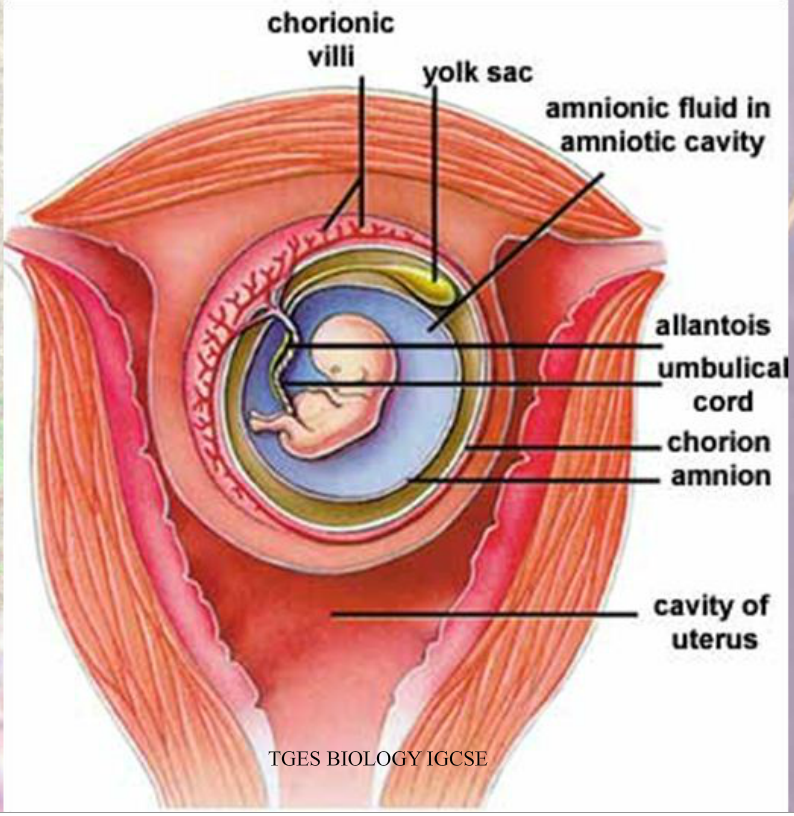 This increase in the amniotic fluid also causes elongation of the connecting stalk, and the yolk sac is compressed down within the connecting stalk to form the omphalomesenteric or vitelline duct.[1][2][5] The expansion of the amniotic cavity causes the amnion and the chorion to come into contact, and the extraembryonic mesoderm covering these two layers fuses. As such, the chorionic cavity disappears, leaving the umbilical cord, the composite of the connecting stalk and vitelline duct surrounded by the amnion, floating in the amniotic fluid.[1][2][4]
This increase in the amniotic fluid also causes elongation of the connecting stalk, and the yolk sac is compressed down within the connecting stalk to form the omphalomesenteric or vitelline duct.[1][2][5] The expansion of the amniotic cavity causes the amnion and the chorion to come into contact, and the extraembryonic mesoderm covering these two layers fuses. As such, the chorionic cavity disappears, leaving the umbilical cord, the composite of the connecting stalk and vitelline duct surrounded by the amnion, floating in the amniotic fluid.[1][2][4]
Starting in week three, endothelial precursor cells in the mesoderm surrounding the allantois coalesce to form small capillaries. Vasculogenesis continues, and by the end of the third week, the capillaries have grown to establish a functional vascular network within the connecting stalk. During the same period, the arterial and venous systems within the embryo are developing. The arterial system is initially established as the paired dorsal aortae from which the aortic arches originate. The primitive venous system is initially made up of the umbilical, vitelline, and cardinal systems. Early in the fourth week, two umbilical arteries branch from the paired dorsal aortae to become connected to the vascular network of the umbilical cord.[1] During the fifth week, this connection is obliterated as the umbilical arteries develop their connection to a branch of the fifth pair of lumbar intersegmental arteries that will later become the internal iliac arteries.[1][2][4] The umbilical veins are originally bilateral and drain into the right and left sinus horns of the sinus venosus. The connections of the umbilical veins to the sinus horns regress in the second month with complete regression of the right umbilical vein as the left umbilical vein persists and forms its connection to the ductus venosus within the developing liver.[2][4] With the initiation of fetal heart pumping around week four, the umbilical arteries carry deoxygenated blood to the placenta, and the umbilical vein carries oxygenated blood back to the fetus from the placenta.
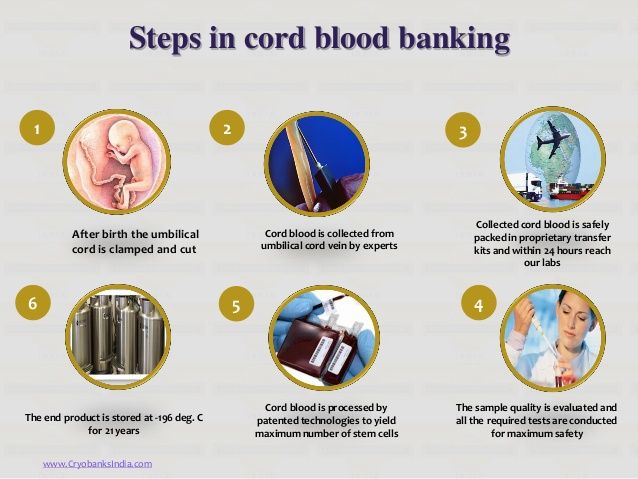 [4]
[4]
By week seven, the intestines begin to herniate out of the embryo through the umbilical ring and into the umbilical cord.[4][6][2] This physiologic herniation is necessary for proper rotation of the intestines and adequate growth of the fetus to house the expanding intestines.[6] The rapid development of the intestines causes elongation of the umbilical cord.[6] Between weeks ten and twelve, the intestines leave the umbilical cord and return to the abdominal cavity.[4][2][6] During this time, the extraembryonic mesoderm develops a rich extracellular matrix to protect the cord called Wharton’s jelly.[2][7] The umbilical cord continues to elongate during the second trimester with a length comparable to the crown-rump length of the fetus.[1][8] By term, the vitelline duct and allantois have typically completely involuted.[1][5] However, in some cases, remnants of the allantois and vitelline duct can be found in the umbilical cord proximal to the neonate.[2][5] At birth, the cord typically measures an average of 50 to 60 cm in length and 2 cm in diameter with up to 40 helical turns.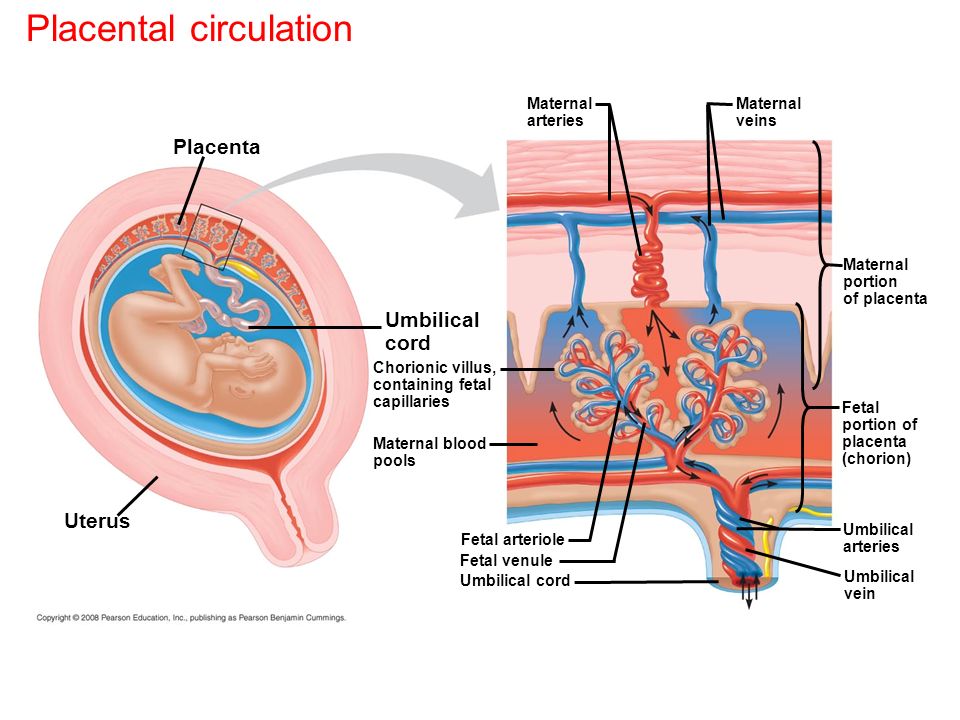 [4][8] After the birth of the neonate, the umbilical cord is clamped and then cut as the neonate now breathes on its own, and the remainder of the umbilical cord is delivered along with the placenta.
[4][8] After the birth of the neonate, the umbilical cord is clamped and then cut as the neonate now breathes on its own, and the remainder of the umbilical cord is delivered along with the placenta.
Cellular
Mesenchymal stem cells found within the Wharton’s jelly of the umbilical cord express c-kit and telomerase activity, consistent with the markers of stem cells.[9][10][11] These cells can be easily extracted after delivery and offer a source of stem cells with fewer ethical considerations than other sources.[7][10] These cells have shown the ability to differentiate into neurons and glia when exposed to specific growth factors.[9] Additionally, these cells may play a role in treating autoimmune disease due to their ability to suppress the secretion of interferon-gamma and transform growth factor-beta1.[10] A more recent study completed on rats showed that transplantation of Wharton’s jelly into the site of traumatic brain injury could reduce the amount of brain damage by reducing brain edema and increasing expression of brain-derived neurotrophic factor.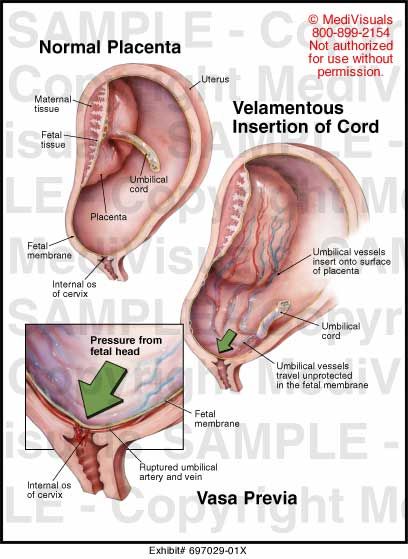 [7] Researchers continue to investigate Wharton’s jelly and mesenchymal stem cells for their potential therapeutic and technological roles.[10][12][13]
[7] Researchers continue to investigate Wharton’s jelly and mesenchymal stem cells for their potential therapeutic and technological roles.[10][12][13]
Biochemical
The Wharton’s jelly of the umbilical cord is a gelatin-like structure rich in proteoglycans, specifically hyaluronic acid and chondroitin sulfate.[11] Hyaluronic acid is present throughout the body in connective and epithelial tissues.[14] It is a disaccharide polymer made of alternating glycosidic bonds between D-glucuronic acid and N-acetyl-D-glucosamine.[14][15] The number of repeats differs between tissues, but hyaluronic acid purified from the umbilical cord is 3,140,000 Da in size.[16] Chondroitin sulfate is a disaccharide consisting of repeats of N-acetylgalactosamine and iduronic acid.[15] Together, these compounds contribute to cellular hydration and the scaffolding of the umbilical cord.[11][15]
Molecular
Wharton’s jelly is the gelatinous extracellular matrix contained within the umbilical cord that serves as protection for the umbilical vessels.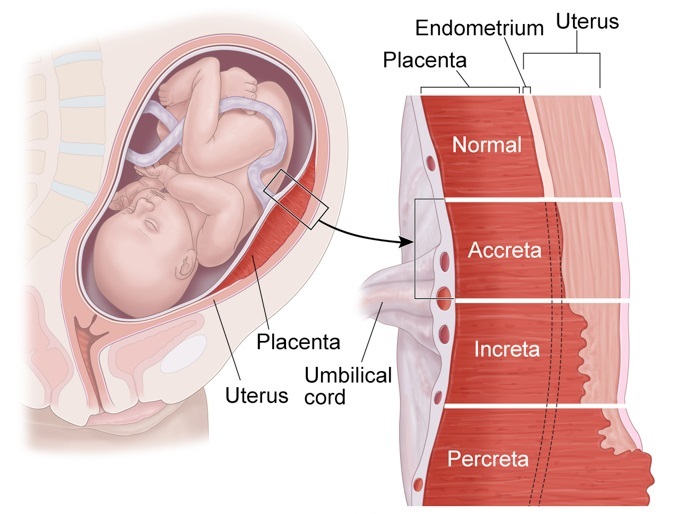 [9][17][4] It prevents the umbilical cord from compressing and provides flexibility to allow for fetal movement within the amniotic cavity.[4][17] It originates from the extraembryonic mesoderm and contains proteoglycans, specifically hyaluronic acid and chondroitin sulfate.[11][17][18] As opposed to other tissues in the body, Wharton’s jelly contains no capillaries.[11] When exposed to temperature changes, such as after delivery of the fetus, the structure of Wharton’s jelly collapses, contributing to the physiological clamping of the cord.[19]
[9][17][4] It prevents the umbilical cord from compressing and provides flexibility to allow for fetal movement within the amniotic cavity.[4][17] It originates from the extraembryonic mesoderm and contains proteoglycans, specifically hyaluronic acid and chondroitin sulfate.[11][17][18] As opposed to other tissues in the body, Wharton’s jelly contains no capillaries.[11] When exposed to temperature changes, such as after delivery of the fetus, the structure of Wharton’s jelly collapses, contributing to the physiological clamping of the cord.[19]
Function
The main function of the umbilical cord is to house the umbilical vessels, which circulate blood between the embryo and the placenta. The umbilical arteries and veins are the vital connection carrying blood between the growing fetus and the placenta.[4] Without this connection to the placenta, the fetus would have no way to receive oxygen and other nutrients or filter out carbon dioxide, urea, and other waste products.[4][20] With the expansion of the amniotic cavity and elongation of the umbilical cord, the fetus has ample space for movement and growth. [4][21][17] During this time in utero, Wharton’s jelly protects the umbilical vessels so the fetus can move and turn without compression of its blood supply.[7][17][22]
[4][21][17] During this time in utero, Wharton’s jelly protects the umbilical vessels so the fetus can move and turn without compression of its blood supply.[7][17][22]
Mechanism
The umbilical vein carries fetal blood from the placenta to the fetus, providing the necessary oxygen and nutrients.[4] Normally found at the 12 o'clock position when facing the umbilicus of the fetus, the umbilical vein is recognizable by its thinner wall and larger lumen in comparison to the arteries.[8][23][2] Blood flowing through the umbilical vein enters the fetus through the umbilical ring and passes through ductus venosus before entering the inferior vena cava.[8][23] In return, the two umbilical arteries carry deoxygenated fetal blood containing waste products from the internal iliac arteries back to the placenta.[4][23] The exchange of these materials happens in the intervillous spaces of the placenta between the maternal and fetal blood supplies.[4][20] Wharton's jelly, the gelatin-like extracellular matrix surrounding the umbilical vessels, provides an elastic cushioning resistant to compression and twisting, allowing for continued blood flow with fetal movement.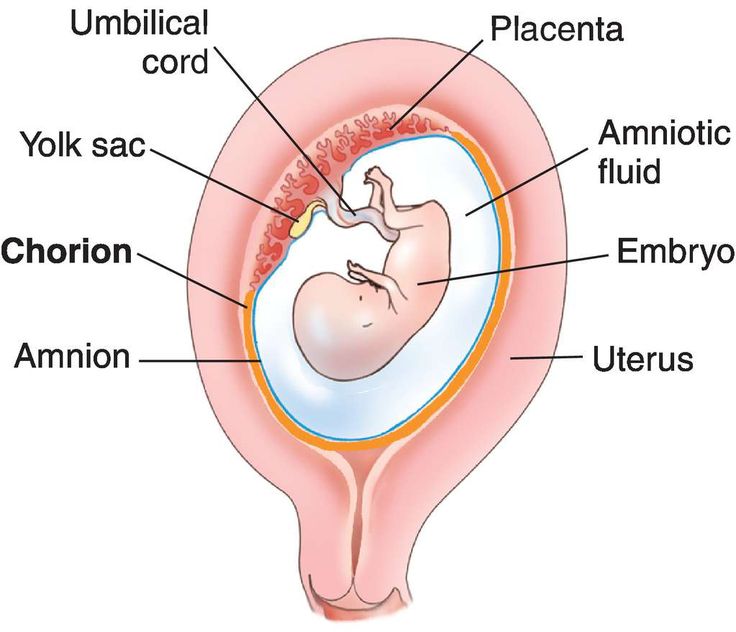 [7][17][21][22][4] There are several hypotheses regarding how the umbilical cord develops its helices, including differential flow through umbilical arteries and twisting of the intestines within the cord. The belief is that adequate coiling contributes to the strength of Wharton's jelly in protecting the umbilical vessels from compression.[4][17]
[7][17][21][22][4] There are several hypotheses regarding how the umbilical cord develops its helices, including differential flow through umbilical arteries and twisting of the intestines within the cord. The belief is that adequate coiling contributes to the strength of Wharton's jelly in protecting the umbilical vessels from compression.[4][17]
After birth, closure of the umbilical arteries initiates by the contraction of circularly arranged smooth muscle within the vascular wall.[19][2] Physiologic closure of the umbilical vein occurs after the umbilical arteries, allowing for prolonged communication and possible transfusion of the remaining placental blood to the neonate.[2][8] The remnants of the umbilical arteries within the neonate become the medial umbilical ligaments, found on the anterior abdominal wall running from the umbilicus inferiorly to the pelvis.[2][19] The remnant of the umbilical vein becomes the ligamentum teres hepatis, which extends superiorly from the umbilicus to connect to the falciform ligament of the liver. [2][8]
[2][8]
Testing
The most useful investigational tool in utero is the ultrasound.[4] It can be useful in the evaluation of fetal anatomy, measuring amniotic fluid levels, watching for fetal movement, and visualizing fetal blood flow. Continuous Doppler ultrasound can visualize the blood flow through the umbilical artery.[4][24][25] This information is then used to create a velocity waveform that can predict the amount of vascular resistance in the placenta.[4] A high placental vascular resistance is associated with intrauterine growth restriction, and the presence of abnormal reverse flow through the umbilical artery can help to determine the need for early delivery.[4][24] When assessing high-risk pregnancies, the evaluation of umbilical artery Doppler velocimetry is utilized to decrease perinatal mortality.[25] Additionally, during high-risk deliveries and in cases of neonatal depression, umbilical cord arterial blood gases should be collected.[23] Umbilical artery pH and gas analysis are the most reliable tests to assess fetal oxygenation and acid-base in the perinatal period directly.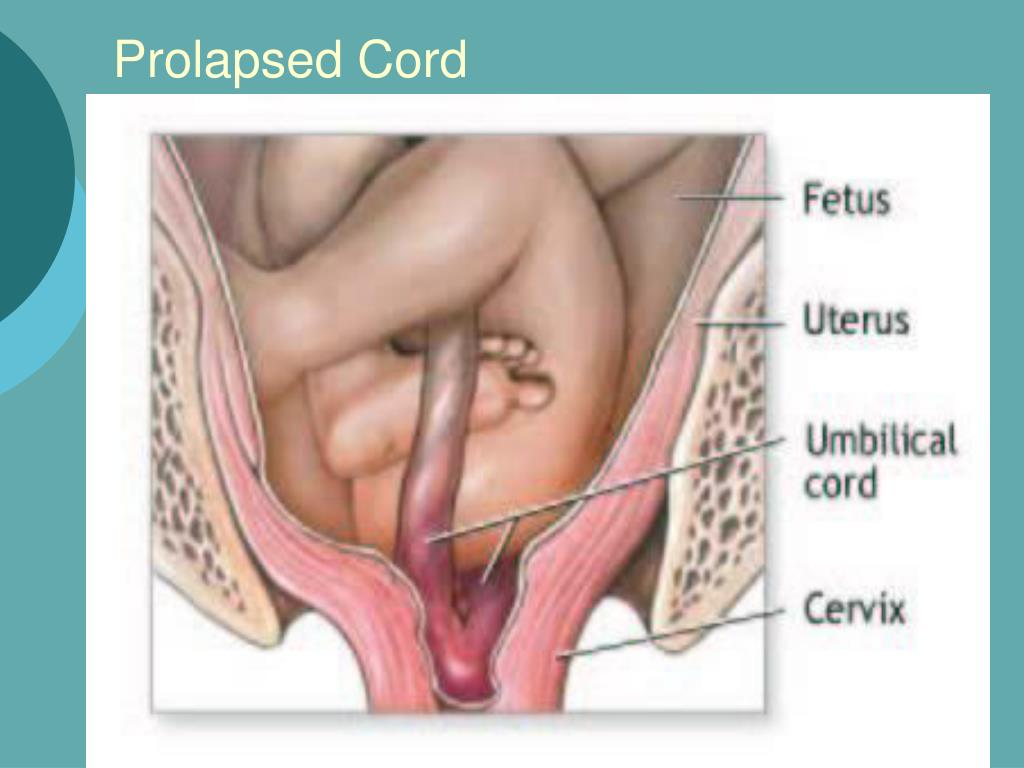 A normal pH and gas analysis at delivery rules out intrapartum asphyxia.[23]
A normal pH and gas analysis at delivery rules out intrapartum asphyxia.[23]
Pathophysiology
A single umbilical artery occurs in less than 1% of all pregnancies due to primary agenesis or secondary atrophy. Over half of these are isolated single umbilical arteries, but the anomaly is also associated with an increased risk of congenital and chromosomal abnormalities. Additionally, a single umbilical artery correlates with prematurity and intrauterine growth restriction.[4][26][27][1][28]
When the umbilical cord inserts near the margin of the placenta instead of the center, it is referred to as marginal cord insertion or battledore placenta; this occurs at a rate of 9% in singleton pregnancies, with an increased rate in twin pregnancies (24 to 33%). Marginal cord insertion is associated with intrauterine growth restriction, preterm labor, and fetal distress.[3][4][28]
Velamentous cord insertion is a type of abnormal insertion occurring in 1 to 2% of pregnancies in which the umbilical vessels begin to spread out before reaching their normal insertion site at the center of the placenta.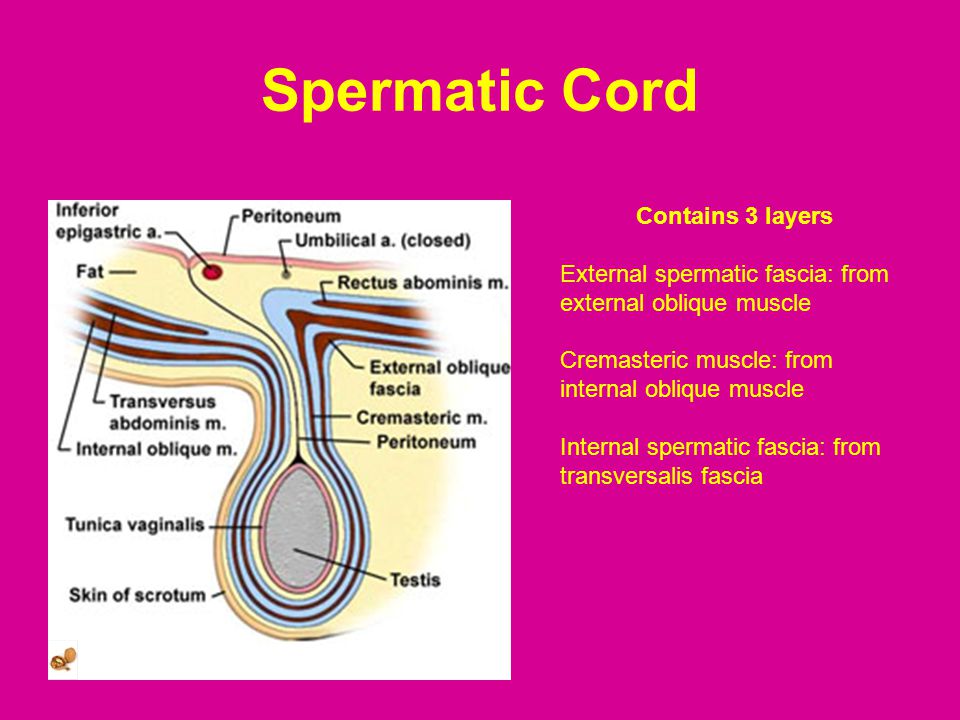 In this anomaly, the vessels travel separately between the amnion and chorion before reaching the placenta. This area lacks the normal protection by Wharton’s jelly, leaving it susceptible to compression and rupture. Velamentous cord insertion increases the risk of adverse outcomes in the perinatal period due to vasa previa and placental abruption.[3][4][28][29]
In this anomaly, the vessels travel separately between the amnion and chorion before reaching the placenta. This area lacks the normal protection by Wharton’s jelly, leaving it susceptible to compression and rupture. Velamentous cord insertion increases the risk of adverse outcomes in the perinatal period due to vasa previa and placental abruption.[3][4][28][29]
Vasa previa occurs in about 0.04% of pregnancies when fetal vessels are located between the cervix and the fetal presenting part and can result from velamentous cord insertion or vessels traveling between lobes of the placenta. If pregnancy progresses to rupture of membranes, vasa previa presents with the combination of painless vaginal bleeding and fetal heart tones showing signs of distress.[4][29][30][28]
Loss of Wharton’s jelly occurs most commonly near the fetal insertion site but also presents near the placental insertion site. The loss of this protective material leaves the umbilical cord vessels susceptible to compression due to twisting and knotting. The absence of Wharton’s jelly at any location on the umbilical cord increases the risk of intrauterine fetal demise as well as adverse perinatal outcomes due to compression of vessels during labor. Loss of Wharton’s jelly may be diagnosable before delivery, with a decreased diameter of the umbilical cord visualized by ultrasound.[4][22]
The absence of Wharton’s jelly at any location on the umbilical cord increases the risk of intrauterine fetal demise as well as adverse perinatal outcomes due to compression of vessels during labor. Loss of Wharton’s jelly may be diagnosable before delivery, with a decreased diameter of the umbilical cord visualized by ultrasound.[4][22]
When the vitelline duct fails to regress during the embryonic period completely, it can lead to the formation of an abnormal outpouching of the intestines referred to as a Meckel’s diverticulum. This outpouching persists in about 2% of neonates, usually measures around 2 inches in length, and is typically located in the ileum about 2 feet from the ileocecal valve (following the rule of 2’s). Partial regression of the duct can lead to a vitelline fistula, a fibrous band-like connection between the umbilicus and intestine, or a vitelline cyst, which is an abnormal collection of fluid within the remaining duct. In most cases, these anomalies are asymptomatic, but the abnormal connection is known to increase the risk of internal hernia, volvulus, and intussusception. [2][5]
[2][5]
Funisitis is the migration of fetal neutrophils out of the bloodstream and into the umbilical cord. This migration process initiates with the release of neutrophil chemokines, such as interleukin-8 and granulocyte chemotactic protein. Funisitis is most commonly present in the setting of intraamniotic infection, specifically chorioamnionitis, and is part of the fetal inflammatory response syndrome, which indicates a high risk of preterm labor and increased neonatal morbidity. This process is identified microscopically after delivery, but due to the need for mature neutrophils within fetal blood, it is not typically present before 20 weeks of gestation.[31]
If the umbilical cord becomes too long in utero, there is an increased risk that it can become wound around the fetus or even become tied into a knot due to fetal movement. If the cord becomes wound around the fetal neck, it is referred to as a nuchal cord. The incidence of the nuchal cord is estimated at up to 29% at term, with the incidence increasing relative to gestational age.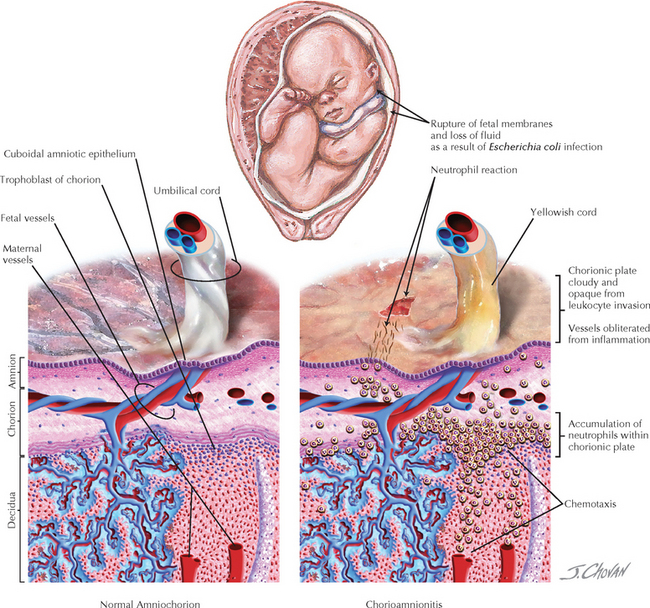 When the fetus descends during labor, increased torsional forces on the umbilical cord can decrease blood flow through the umbilical vessels and lead to signs of fetal distress and acidosis. When discovered, expedient reduction of the nuchal cord is important to return proper blood flow to the fetus and avoid prolonged asphyxia.[4][17]
When the fetus descends during labor, increased torsional forces on the umbilical cord can decrease blood flow through the umbilical vessels and lead to signs of fetal distress and acidosis. When discovered, expedient reduction of the nuchal cord is important to return proper blood flow to the fetus and avoid prolonged asphyxia.[4][17]
Similarly, knots that form in utero are associated with longer umbilical cords. Loose umbilical knots present no danger to the fetus on their own, but when the knot tightens, the increased compression on the cord initially collapses the thin-walled vein before the thicker-walled arteries. This tightening of the knot can happen in utero and during labor, leading to signs of fetal distress, asphyxia, or even intrauterine fetal demise.[4][17][21]
Additionally, longer umbilical cords are more likely to lie between the cervix and the presenting fetal part during delivery leading to possible umbilical cord prolapse with rupture of membranes. Umbilical cord prolapse is diagnosed by palpation of the umbilical cord within the vagina along with changes in the fetal heart tracing indicating fetal distress, such as recurrent and prolonged decelerations. Management of this condition is expedient delivery of the baby, mostly via cesarean section, but operational vaginal delivery may be performed if that is determined to be the faster route.[4][32]
Management of this condition is expedient delivery of the baby, mostly via cesarean section, but operational vaginal delivery may be performed if that is determined to be the faster route.[4][32]
In monochorionic monoamniotic twin gestations, the fetuses share the same amniotic cavity within the uterus leading to possible cord entanglement. Similar to a knotted cord, tightening of the cord entanglement and increasing entanglement can cause compression of fetal vessels leading to intrauterine fetal demise. Cord entanglement can be detected in utero by ultrasound, but studies suggest that prenatal diagnosis has not shown improved neonatal outcomes.[4][28]
Other rare abnormalities include persistent right umbilical vein, umbilical artery aneurysm, umbilical cord cyst, umbilical hemangioma, and umbilical teratoma.[4]
Clinical Significance
The umbilical cord is the vital connection between the fetus and the placenta. Without this connection, the fetus would be unable to receive oxygen and nutrients from the mother or remove carbon dioxide and other waste products.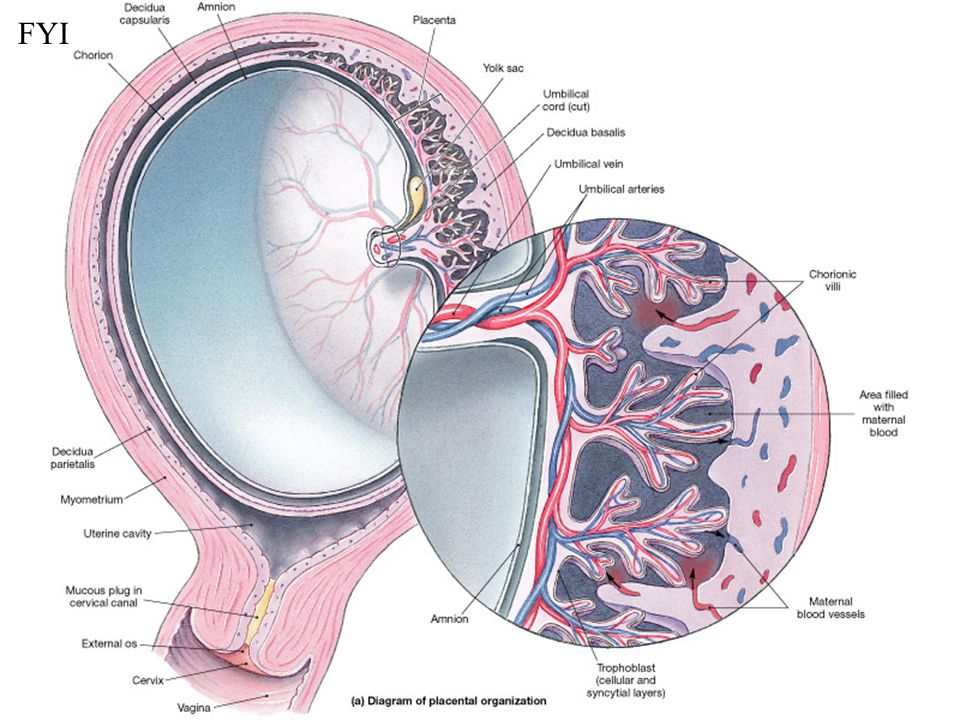 [4] Sonographic analysis of the umbilical cord in the antepartum period is important for the early diagnosis of umbilical abnormalities.[4][2][25] Early recognition of abnormalities, such as velamentous cord insertion and nuchal cord, can improve perinatal outcomes.[4][17][29] Detection of any abnormality early in pregnancy should lead to serial ultrasound examinations to evaluate the patient for any associated complications.[4]
[4] Sonographic analysis of the umbilical cord in the antepartum period is important for the early diagnosis of umbilical abnormalities.[4][2][25] Early recognition of abnormalities, such as velamentous cord insertion and nuchal cord, can improve perinatal outcomes.[4][17][29] Detection of any abnormality early in pregnancy should lead to serial ultrasound examinations to evaluate the patient for any associated complications.[4]
Possible adverse outcomes of umbilical cord abnormalities include intrauterine growth restriction, preterm labor, fetal distress and asphyxia, and even intrauterine fetal demise.[4] After delivery, the portion of the cord remaining attached to the fetus may be useful for intravenous access by umbilical vein catheterization.[2][8] This can be used for transfusions and resuscitation of the neonate while the vessel is still patent, up to 14 days.[8] Additionally, umbilical cord blood has been used as an alternative source for bone marrow transplants since 1988 due to the presence of hematopoietic stem cells.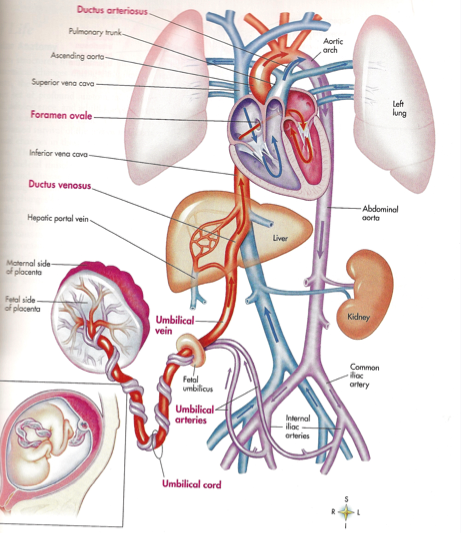 [33] Umbilical cord blood transplantation has successfully helped to cure patients with hematologic diseases through the transplantation of allogeneic hematopoietic stem cells.[33] Furthermore, the therapeutic roles of Wharton’s jelly and the stem cells found within the umbilical cord are still under investigation.[10][12][13]
[33] Umbilical cord blood transplantation has successfully helped to cure patients with hematologic diseases through the transplantation of allogeneic hematopoietic stem cells.[33] Furthermore, the therapeutic roles of Wharton’s jelly and the stem cells found within the umbilical cord are still under investigation.[10][12][13]
Review Questions
Access free multiple choice questions on this topic.
Comment on this article.
Figure
Development of the Fetal membrane and the Placenta, Diagram illustrating a later stage in the development of the umbilical cord, Placental villi, Umbilical cord, Allantois, Heart, Embryo. Contributed by Gray's Anatomy Plates
Figure
Development of the Fetal Membranes and Placenta, Fetus of about eight weeks; enclosed in the amnion, Umbilical cord, Chorionic, Placenta. Contributed by Gray's Anatomy Plates
Figure
Development of Fetal Membranes and Placenta, Fetus in utero; between fifth and sixth months, Umbilical cord, Cervix uteri. Contributed by Gray's Anatomy Plates
Figure
The Branchial Region, Embryo of about six weeks, Umbilical cord, Embryology. Contributed by Gray's Anatomy Plates
Figure
Umbilical cord. Image courtesy S Bhimji MD
References
- 1.
Persutte WH, Hobbins J. Single umbilical artery: a clinical enigma in modern prenatal diagnosis. Ultrasound Obstet Gynecol. 1995 Sep;6(3):216-29. [PubMed: 8521073]
- 2.
Hegazy AA. Anatomy and embryology of umbilicus in newborns: a review and clinical correlations. Front Med. 2016 Sep;10(3):271-7. [PubMed: 27473223]
- 3.
Rathbun KM, Hildebrand JP. StatPearls [Internet]. StatPearls Publishing; Treasure Island (FL): Oct 5, 2022. Placenta Abnormalities. [PubMed: 29083591]
- 4.
Moshiri M, Zaidi SF, Robinson TJ, Bhargava P, Siebert JR, Dubinsky TJ, Katz DS. Comprehensive imaging review of abnormalities of the umbilical cord. Radiographics. 2014 Jan-Feb;34(1):179-96.
 [PubMed: 24428290]
[PubMed: 24428290]- 5.
An J, Zabbo CP. StatPearls [Internet]. StatPearls Publishing; Treasure Island (FL): May 26, 2022. Meckel Diverticulum. [PubMed: 29763135]
- 6.
Malone JC, Shah AB. StatPearls [Internet]. StatPearls Publishing; Treasure Island (FL): Feb 10, 2022. Embryology, Midgut. [PubMed: 31985949]
- 7.
Cheng T, Yang B, Li D, Ma S, Tian Y, Qu R, Zhang W, Zhang Y, Hu K, Guan F, Wang J. Wharton's Jelly Transplantation Improves Neurologic Function in a Rat Model of Traumatic Brain Injury. Cell Mol Neurobiol. 2015 Jul;35(5):641-9. [PMC free article: PMC4481175] [PubMed: 25638565]
- 8.
Lewis K, Spirnak PW. StatPearls [Internet]. StatPearls Publishing; Treasure Island (FL): Jul 26, 2022. Umbilical Vein Catheterization. [PubMed: 31751059]
- 9.
Mitchell KE, Weiss ML, Mitchell BM, Martin P, Davis D, Morales L, Helwig B, Beerenstrauch M, Abou-Easa K, Hildreth T, Troyer D, Medicetty S.
 Matrix cells from Wharton's jelly form neurons and glia. Stem Cells. 2003;21(1):50-60. [PubMed: 12529551]
Matrix cells from Wharton's jelly form neurons and glia. Stem Cells. 2003;21(1):50-60. [PubMed: 12529551]- 10.
Zhou C, Yang B, Tian Y, Jiao H, Zheng W, Wang J, Guan F. Immunomodulatory effect of human umbilical cord Wharton's jelly-derived mesenchymal stem cells on lymphocytes. Cell Immunol. 2011;272(1):33-8. [PMC free article: PMC3235326] [PubMed: 22004796]
- 11.
Safari F, Fani N, Eglin D, Alini M, Stoddart MJ, Baghaban Eslaminejad M. Human umbilical cord-derived scaffolds for cartilage tissue engineering. J Biomed Mater Res A. 2019 Aug;107(8):1793-1802. [PubMed: 30983084]
- 12.
Corsello T, Amico G, Corrao S, Anzalone R, Timoneri F, Lo Iacono M, Russo E, Spatola GF, Uzzo ML, Giuffrè M, Caprnda M, Kubatka P, Kruzliak P, Conaldi PG, La Rocca G. Wharton's Jelly Mesenchymal Stromal Cells from Human Umbilical Cord: a Close-up on Immunomodulatory Molecules Featured In Situ and In Vitro. Stem Cell Rev Rep. 2019 Dec;15(6):900-918.
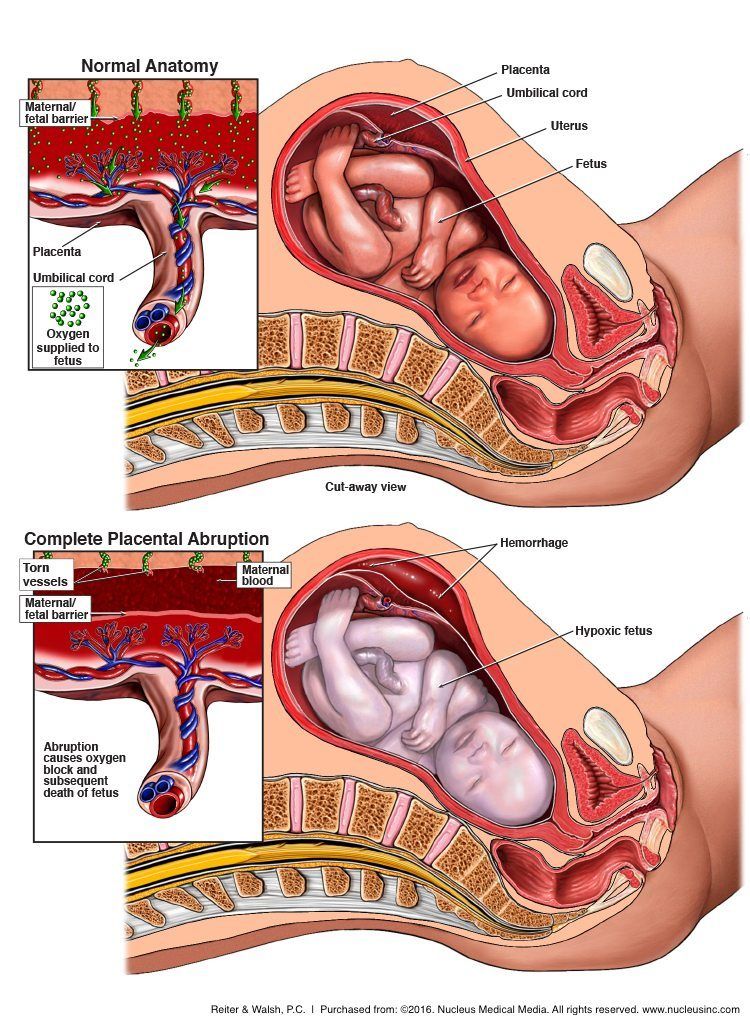 [PubMed: 31741193]
[PubMed: 31741193]- 13.
Nishida F, Zappa Villar MF, Zanuzzi CN, Sisti MS, Camiña AE, Reggiani PC, Portiansky EL. Intracerebroventricular Delivery of Human Umbilical Cord Mesenchymal Stem Cells as a Promising Therapy for Repairing the Spinal Cord Injury Induced by Kainic Acid. Stem Cell Rev Rep. 2020 Feb;16(1):167-180. [PubMed: 31760626]
- 14.
Walker K, Basehore BM, Goyal A, Zito PM. StatPearls [Internet]. StatPearls Publishing; Treasure Island (FL): Aug 25, 2022. Hyaluronic Acid. [PubMed: 29494047]
- 15.
Casale J, Crane JS. StatPearls [Internet]. StatPearls Publishing; Treasure Island (FL): Mar 27, 2022. Biochemistry, Glycosaminoglycans. [PubMed: 31335015]
- 16.
Saari H, Konttinen YT, Friman C, Sorsa T. Differential effects of reactive oxygen species on native synovial fluid and purified human umbilical cord hyaluronate. Inflammation. 1993 Aug;17(4):403-15. [PubMed: 8406685]
- 17.
Peesay M.
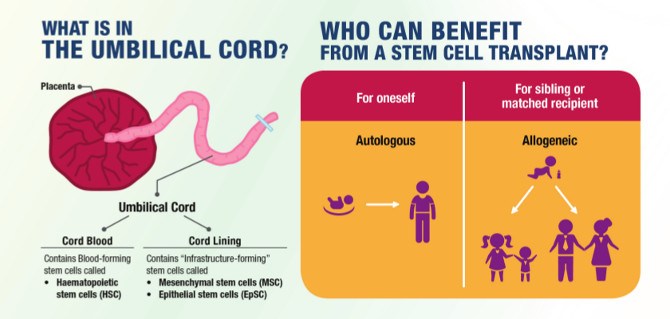 Nuchal cord and its implications. Matern Health Neonatol Perinatol. 2017;3:28. [PMC free article: PMC5719938] [PubMed: 29234502]
Nuchal cord and its implications. Matern Health Neonatol Perinatol. 2017;3:28. [PMC free article: PMC5719938] [PubMed: 29234502]- 18.
Gupta A, El-Amin SF, Levy HJ, Sze-Tu R, Ibim SE, Maffulli N. Umbilical cord-derived Wharton's jelly for regenerative medicine applications. J Orthop Surg Res. 2020 Feb 13;15(1):49. [PMC free article: PMC7017504] [PubMed: 32054483]
- 19.
Meyer WW, Rumpelt HJ, Yao AC, Lind J. Structure and closure mechanism of the human umbilical artery. Eur J Pediatr. 1978 Jul 19;128(4):247-59. [PubMed: 668732]
- 20.
Kapila V, Chaudhry K. StatPearls [Internet]. StatPearls Publishing; Treasure Island (FL): Jul 25, 2022. Physiology, Placenta. [PubMed: 30855916]
- 21.
Sørnes T. Umbilical cord knots. Acta Obstet Gynecol Scand. 2000 Mar;79(3):157-9. [PubMed: 10716294]
- 22.
Damasceno EB, de Lima PP. Wharton's jelly absence: a possible cause of stillbirth. Autops Case Rep.
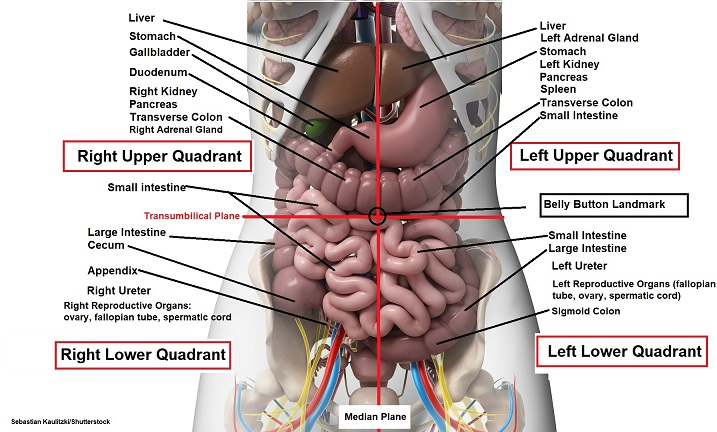 2013 Oct-Dec;3(4):43-47. [PMC free article: PMC5453660] [PubMed: 28584806]
2013 Oct-Dec;3(4):43-47. [PMC free article: PMC5453660] [PubMed: 28584806]- 23.
Thorp JA, Rushing RS. Umbilical cord blood gas analysis. Obstet Gynecol Clin North Am. 1999 Dec;26(4):695-709. [PubMed: 10587963]
- 24.
Fleischer A, Schulman H, Farmakides G, Bracero L, Blattner P, Randolph G. Umbilical artery velocity waveforms and intrauterine growth retardation. Am J Obstet Gynecol. 1985 Feb 15;151(4):502-5. [PubMed: 3976751]
- 25.
Divon MY. Umbilical artery Doppler velocimetry: clinical utility in high-risk pregnancies. Am J Obstet Gynecol. 1996 Jan;174(1 Pt 1):10-4. [PubMed: 8571990]
- 26.
Murphy-Kaulbeck L, Dodds L, Joseph KS, Van den Hof M. Single umbilical artery risk factors and pregnancy outcomes. Obstet Gynecol. 2010 Oct;116(4):843-850. [PubMed: 20859147]
- 27.
Ramesh S, Hariprasath S, Anandan G, Solomon PJ, Vijayakumar V. Single umbilical artery. J Pharm Bioallied Sci. 2015 Apr;7(Suppl 1):S83-4.
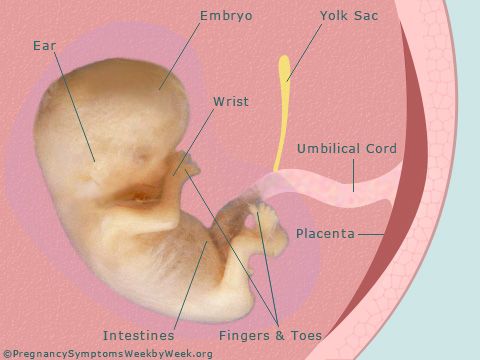 [PMC free article: PMC4439720] [PubMed: 26015760]
[PMC free article: PMC4439720] [PubMed: 26015760]- 28.
Hubinont C, Lewi L, Bernard P, Marbaix E, Debiève F, Jauniaux E. Anomalies of the placenta and umbilical cord in twin gestations. Am J Obstet Gynecol. 2015 Oct;213(4 Suppl):S91-S102. [PubMed: 26428508]
- 29.
Rocha J, Carvalho J, Costa F, Meireles I, do Carmo O. Velamentous cord insertion in a singleton pregnancy: an obscure cause of emergency cesarean-a case report. Case Rep Obstet Gynecol. 2012;2012:308206. [PMC free article: PMC3517836] [PubMed: 23243528]
- 30.
Derbala Y, Grochal F, Jeanty P. Vasa previa. J Prenat Med. 2007 Jan;1(1):2-13. [PMC free article: PMC3309346] [PubMed: 22470817]
- 31.
Kim CJ, Romero R, Chaemsaithong P, Chaiyasit N, Yoon BH, Kim YM. Acute chorioamnionitis and funisitis: definition, pathologic features, and clinical significance. Am J Obstet Gynecol. 2015 Oct;213(4 Suppl):S29-52. [PMC free article: PMC4774647] [PubMed: 26428501]
- 32.
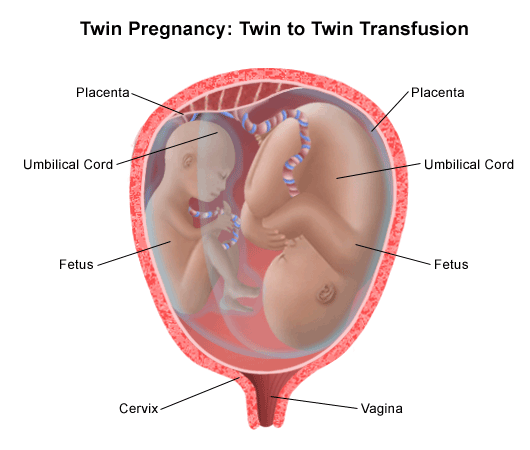
Sayed Ahmed WA, Hamdy MA. Optimal management of umbilical cord prolapse. Int J Womens Health. 2018;10:459-465. [PMC free article: PMC6109652] [PubMed: 30174462]
- 33.
Ballen KK, Gluckman E, Broxmeyer HE. Umbilical cord blood transplantation: the first 25 years and beyond. Blood. 2013 Jul 25;122(4):491-8. [PMC free article: PMC3952633] [PubMed: 23673863]
The wonderful world of the navel: where does the wool come from?
- Jason Goldman
- BBC Future
Sign up for our 'Context' newsletter to help you understand what's going on.
Image copyright, Getty
Image caption,Perhaps the formation of umbilical pellets helps to cleanse the navel of bacteria
Why do some people have a clean navel during the day, while others have to extract a fluffy ball from it every evening? The correspondent was looking for the answer to this question BBC Future .
Here's what you need to know about umbilical cords - hairballs that form in the navel: they are most common in middle-aged, hairy men, especially those who have recently put on weight.
Dr. Carl Krushelnicki of the University of Sydney came to this conclusion. Dr. Carl, as his fans call him, hosts a science radio show. One of the listeners once asked him a question where the umbilical pellets come from. Krushelnicki thought about it and decided to conduct an Internet study, according to the results of which he concluded that umbilical hair occurs mainly in middle-aged men with a lot of body hair. For this research, in 2002, he was awarded the Ig Nobel Prize, awarded "for achievements that make you first laugh, and then think." nine0011
In addition to the online study, Krushelnytsky and a group of colleagues collected navel hair samples from volunteers and asked them to wash the hair around the navel. It turned out that water procedures really prevent the formation of spools.
(More BBC Future articles in Russian)
Dr. Carl and colleagues may not be the world's leading experts in the field, but their explanation for umbilical hair formation is at least intuitive. The hair around the navel, in their opinion, plays the role of a one-way ratchet - it picks up the smallest fibers of fabric from the inside of the clothes and moves them to the navel. nine0011
The older the clothes, the less pilling
Krushelnicki is not the only one interested in the mechanism of navel hair. In 2009, researcher Georg Steinhauser of the Technical University of Vienna wrote an article on the same topic in the journal Medical Hypotheses. For reasons known only to himself, Steinhauser collected his own umbilical pellets every evening for three years. Although, according to his assurances, he is quite clean and takes a shower every day, at the end of the day, a ball of wool invariably forms in Steinhauser's navel. nine0011
Altogether Steinhauser collected 503 of these pellets weighing less than a gram. On average, each lump weighed 1.82 mg, although seven samples exceeded the weight of 7.2 mg, and the winner was the 9.17-milligram giant.
Image copyright, Getty
Image caption,The color of the umbilical coat usually matches the predominant color of the hairs that make up the fur
Skip the Podcast and continue reading.
Podcast
What was that?
We quickly, simply and clearly explain what happened, why it's important and what's next. nine0011
episodes
End of Story Podcast
"The spools were clearly cotton lint, since they were the same color as the clothes I wore on any given day," Steinhauser wrote. Moreover, the size of the pellets was smaller when wearing suit shirts, as well as old T-shirts - in the latter case, this is probably due to the fact that there were already very few villi left on the fabric.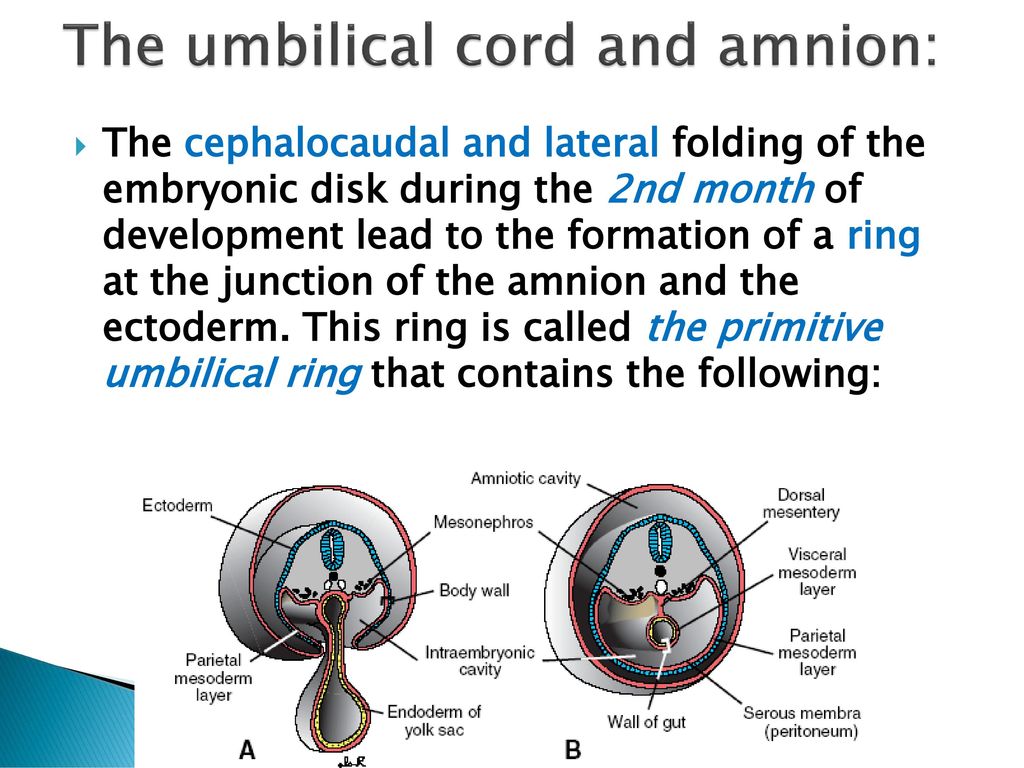
Steinhauser came to the same conclusion as Krushelnicki: the hair growing around the navel is responsible for the formation of the pellets. He suggested that it was the hairs that collected the villi from the clothes, and then sent them to the navel. "Hair scales act like fishhooks," the researcher wrote. nine0011
When Steinhauser shaved the hair around the navel, he found that, as in the case of Dr. Carl's volunteers, it was enough to stop the process of navel hair formation.
But Steinhauser went even further. He analyzed the chemical composition of the pellet that formed in his navel after wearing a white 100% cotton T-shirt. If the sample consisted entirely of lint from a T-shirt, the analysis would show only cellulose in the pellet. However, the researcher found the presence of other particles - dust, skin flakes, fat and protein cells, as well as sweat. nine0011
Apparently the belly hairs don't care what to pick up.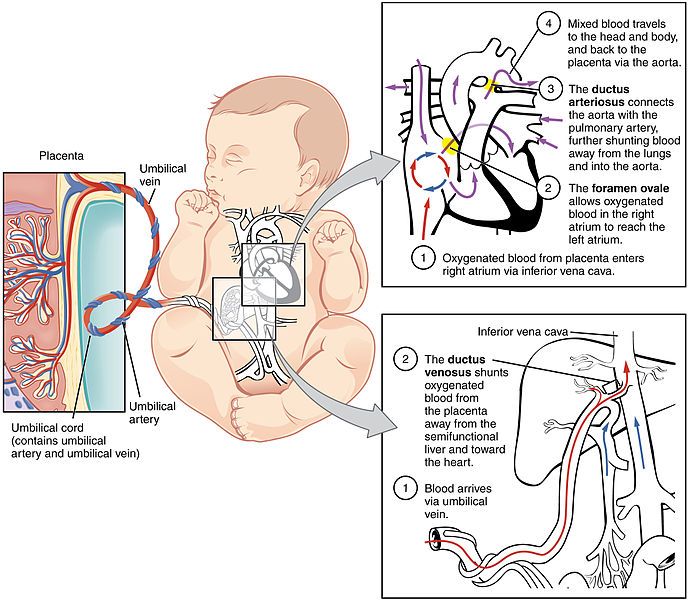 Based on these results, Steinhauser concluded that those of us who "produce" navel hair should have cleaner navels in general, since other types of pollution are also eliminated in the process of removing the pellets.
Based on these results, Steinhauser concluded that those of us who "produce" navel hair should have cleaner navels in general, since other types of pollution are also eliminated in the process of removing the pellets.
Although not all scientists devote their time and energy to the study of the causes of the formation of umbilical pellets (perhaps Krushelnicki and Steinhauser are generally the only researchers who are interested in this topic), a serious study is now being carried out at the University of North Carolina to understand what else can be found in the human navel. nine0011
Department of Biology Fellow Rob Dunn established the Belly Button Diversity Project with the University's Center for Behavioral Biology. In 2011, Dunn and colleagues collected navel hair samples from more than 500 volunteers attending the Science Online conference in Raleigh, North Carolina, and the Darwin Day event at the city's natural science museum. The researchers were not interested in villi - they wanted to study the microflora of the navel.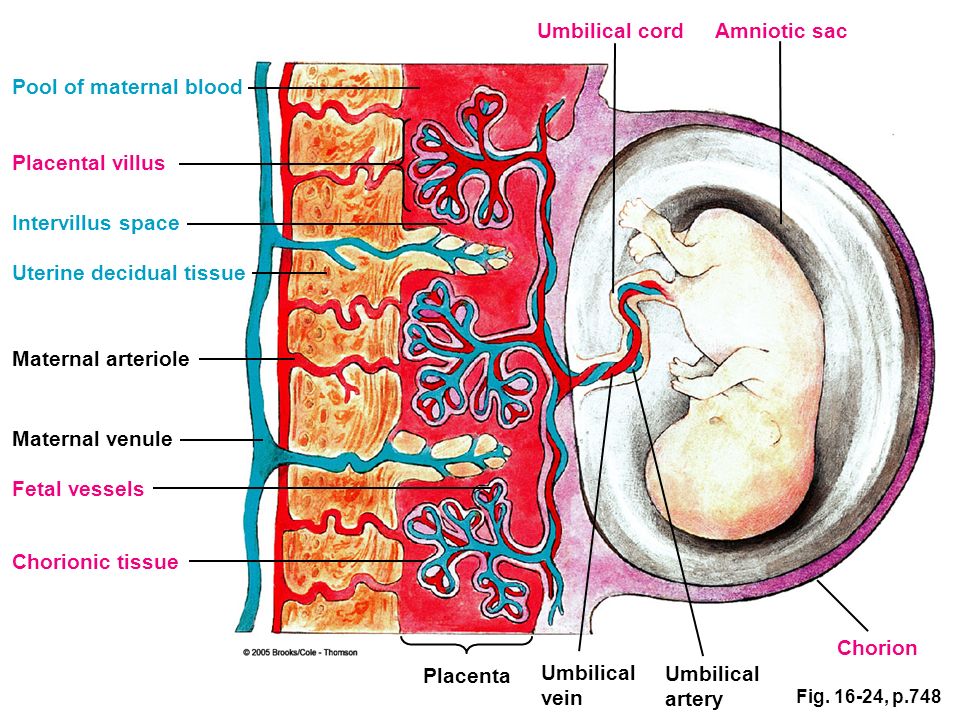 "The navel is one of the closest habitats to us, but it remains relatively little known," the scientists said. nine0011
"The navel is one of the closest habitats to us, but it remains relatively little known," the scientists said. nine0011
Since that very first study (and the researchers have collected more samples since), Dunn's team has uncovered the amazing microbial diversity of the navel, a veritable treasure trove of microscopic life forms.
Adaptation to life in the navel
In the first batch of 60 samples, scientists found at least 2368 species of microorganisms. They suspect that the real figure is likely to be even higher. But the number of bacteria found is more than twice the diversity of bird or ant species that inhabit North America. nine0011
However, most of the species found are rare, with 2128 found in the navels of five or fewer test subjects. In fact, the largest number of bacterial species was present in the navel of a single volunteer.
Photo copyright, Getty
Image caption,Navel pellets also form in those who shower every day
Despite this amazing diversity, the vast majority of bacteria living in human navels belong to just a few species. Although the researchers were unable to detect a single bacterial species that was typical of the umbilical flora of all subjects, eight species were found in the navels of at least 70% of the volunteers. The total number of organisms of these species accounted for almost half of the total number of all bacteria found. nine0011
The researchers also found three species of archaea, bacteria commonly found in extreme environments. Interestingly, two of the three species were found in the navel of the same volunteer, who admitted he hadn't showered in years.
Where did this variety of umbilical flora come from? Dunn's team suspects that eight of the most typical species of bacteria have adapted to life on human skin - or perhaps in the navel itself - while other species only occasionally visit the distant navel shores. nine0011
Scientists draw an analogy with the diversity of fish species at the mouth of a river. Permanent residents have adapted to this environment, while other species that can swim in the river for a short time are not adapted to long-term survival in local conditions.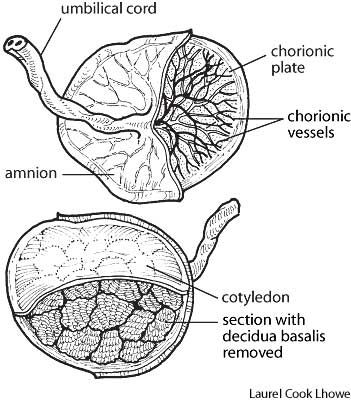 Similarly, a disproportionate number of trees of certain species in rainforests adapt to the local climate. Other species, although able to grow in tropical soil, are not able to form colonies. nine0011
Similarly, a disproportionate number of trees of certain species in rainforests adapt to the local climate. Other species, although able to grow in tropical soil, are not able to form colonies. nine0011
While the diversity of microorganisms makes it impossible to predict which types of bacteria can be found in an individual's navel, researchers are able to suggest which types are most common.
So, even if your navel does not form pellets, you should not be sad - it is still a very densely populated area, life is in full swing there.
Read the original of this article in English is available on site BBC Future .
Where does an umbilical hernia come from and how to treat it
July 9, 2020 Likbez Health
It can actually come from lifting weights.
What is an umbilical hernia
This type of hernia occurs when the muscles of the abdominal wall separate and part of the intestine protrudes through the dilated umbilical opening.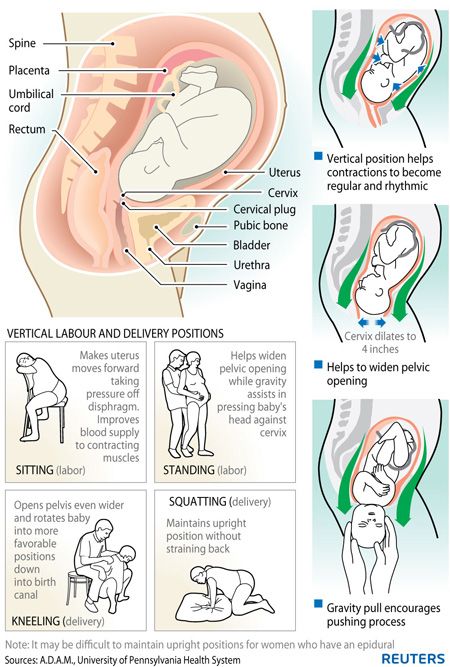
This is common in babies, especially those born prematurely. When a child starts crying, coughing, or, for example, straining to sit up, the navel begins to bulge noticeably. This is a classic sign of an umbilical hernia. nine0011
Although it can also occur in adulthood.
Why is an umbilical hernia dangerous?
In the case of small children, practically nothing. Abdominal muscle weakness usually resolves with age. By the third or fourth year of life, most children have no trace of an umbilical hernia.
Adults are a special conversation. A hernia formed in non-infancy rarely disappears on its own. The fact is that the muscles that have diverged for some reason are strong enough. Trying to close again, they can pinch the part of the intestine protruding through the umbilical opening. This leads to a number of unpleasant consequences, including:
- Abdominal pain.
- Nausea and vomiting.
- Digestive disorders.
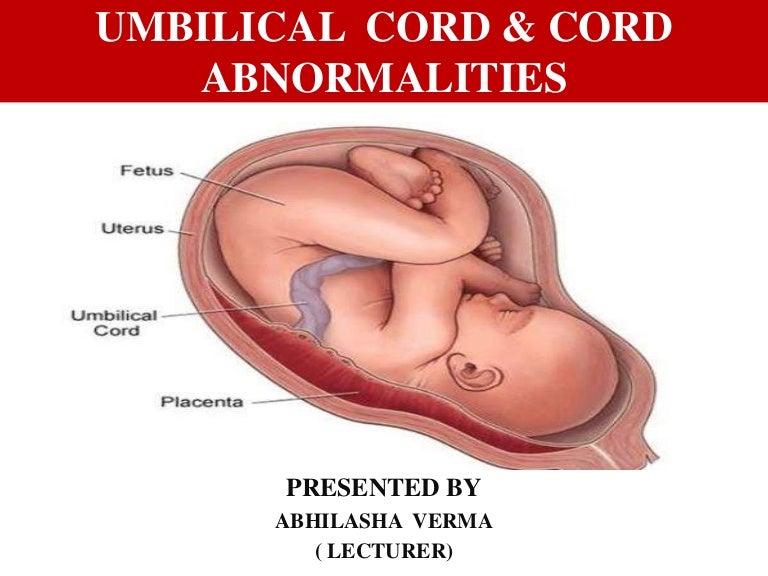
- Intestinal obstruction.
- Necrosis. If the prolapsed part of the intestine receives less blood, it begins to die. This is a deadly situation.
When to seek urgent help
If you find a bulge in the navel area (whether on yourself or on a baby), you should always consult a general practitioner or pediatrician.
Emergency assistance may sometimes be required. Dial 103 or 112 immediately if:
- abdominal pain in the area of a hernia;
- vomiting appeared;
- hernia painful to touch;
- edema has appeared in the area of the hernia or the skin has changed color.
Such symptoms indicate that the matter has come to complications.
Now reading 🔥
- What to do if the temperature is 37 °C
Where does an umbilical hernia come from
Each baby has a muscle divergence in the umbilical region: the umbilical cord passes through this so-called umbilical ring.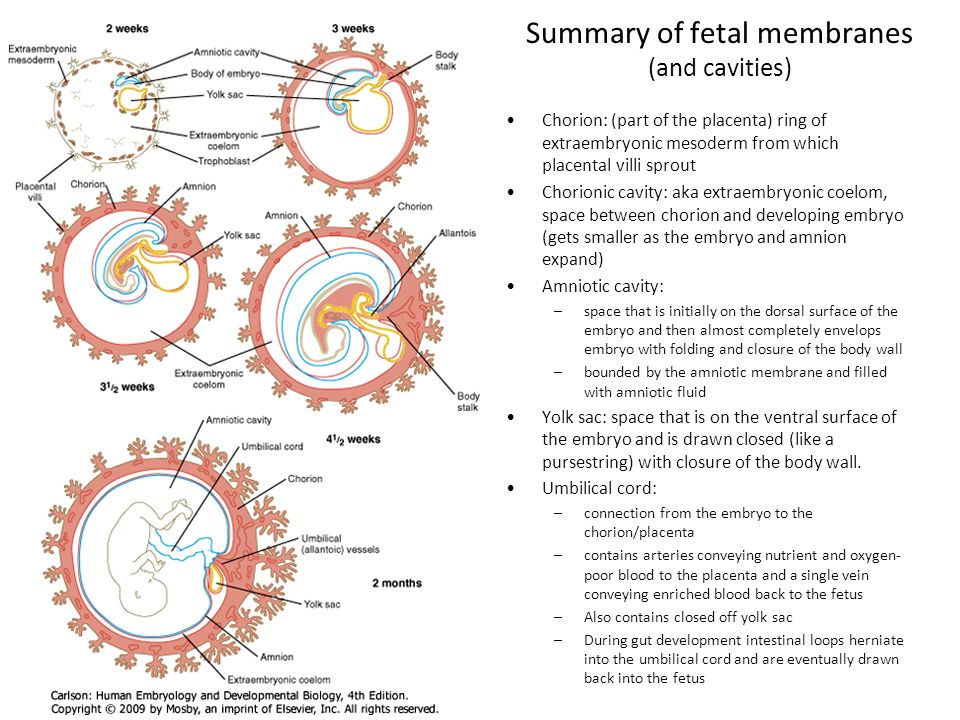 As a rule, the ring shrinks immediately after birth. But for some children, this process can take several months or even years. All this time, the umbilical hernia makes itself felt.
As a rule, the ring shrinks immediately after birth. But for some children, this process can take several months or even years. All this time, the umbilical hernia makes itself felt.
In adults, the causes of a hernia are different: the abdominal muscles separate due to increased stress or pressure inside the abdomen. Such a load can provoke:
- multiple pregnancy;
- overweight or obese;
- recent abdominal surgery;
- heavy lifting;
- persistent severe cough.
How to treat an umbilical hernia
The only way to get rid of a hernia is to have surgery. Children are prescribed it no earlier than three or four years, in the hope that the bulge will disappear on its own. In some cases, a competent pediatrician can push the hernia back into the abdominal cavity. But this method does not always work, and in no case should it be used independently: there is a risk of damaging the intestines. nine0011
In adults, surgery is recommended in any case, even if the hernia is small and does not hurt.





